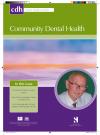Community Dental Health

- Cover Date:
- June 2013
- Print ISSN:
- 0265 539X
- Vol:
- 30
- Issue:
- 2
Analysis of the perceived oral treatment need using Andersen’s behavioural model
doi:10.1922/CDH_2927Lundegren06
Objectives: The aim of this study was to investigate the influence of specific components of Andersen’s behavioural model on adult individuals’ perceived oral treatment need. Methods: A questionnaire was sent to a randomly selected sample of 9,690 individuals, 20 to 89 years old, living in Skåne, Sweden. The 58 questions, some with follow-up questions, were answered by 6,123 individuals; a 63% response rate. Selected for inclusion in the multivariate logistic regression analysis were those questions relating to Andersen’s behavioural model, phase five. Responses to “How do you rate your oral treatment need today?†were used as a dependent variable. The 62 questions chosen as independent variables represented the components: individual characteristics, health behaviour and outcomes in the model. Results: Of the independent variables, 24 were significant at the p≤0.05 level. Low educational level, previously unmet perceived oral treatment need, frequent visiting pattern, perception of worse oral health than one’s peers, an external locus of control, and to have received information from one’s dental caregiver about a need for oral treatment were all highly significant (p<0.001) variables correlating with high self-perceived oral treatment need. Conclusion: The Andersen behavioural model can be a useful theoretical tool for the study of perceived oral treatment need.
Key words: self-assessment, needs and demand, health services, perceived need
- Article Price
- £15.00
- Institution Article Price
- £
- Page Start
- 102
- Page End
- 107
- Authors
- N. Lundegren, B. Axtelius, P-E. Isberg, S. Ã…kerman
Articles from this issue
- Title
- Pg. Start
- Pg. End
- Barriers and facilitators that influence the delivery of prevention guidance in health service dental practice: A questionnaire study of practising dentists in southwest England
- 71
- 76
- Care home managers’ views of dental services for older people living in nursing and residential homes in inner city London
- 77
- 82
- Automated coaching to help parents increase their children’s brushing frequency: an exploratory trial
- 88
- 93
- Operationalisation of the construct of access to dental care: a position paper and proposed conceptual definitions
- 94
- 101
- Sociodemographic differences in oral health-related quality of life related to dental caries in Thai school children
- 112
- 118
- Short Communication - The cross cultural adaptation and validity of the Child-OIDP scale among school children in Karnataka, South India
- 124
- 126
- Short Communication - Defluoridation techniques implemented by the government of Karnataka, India – the current situation
- 127
- 128
